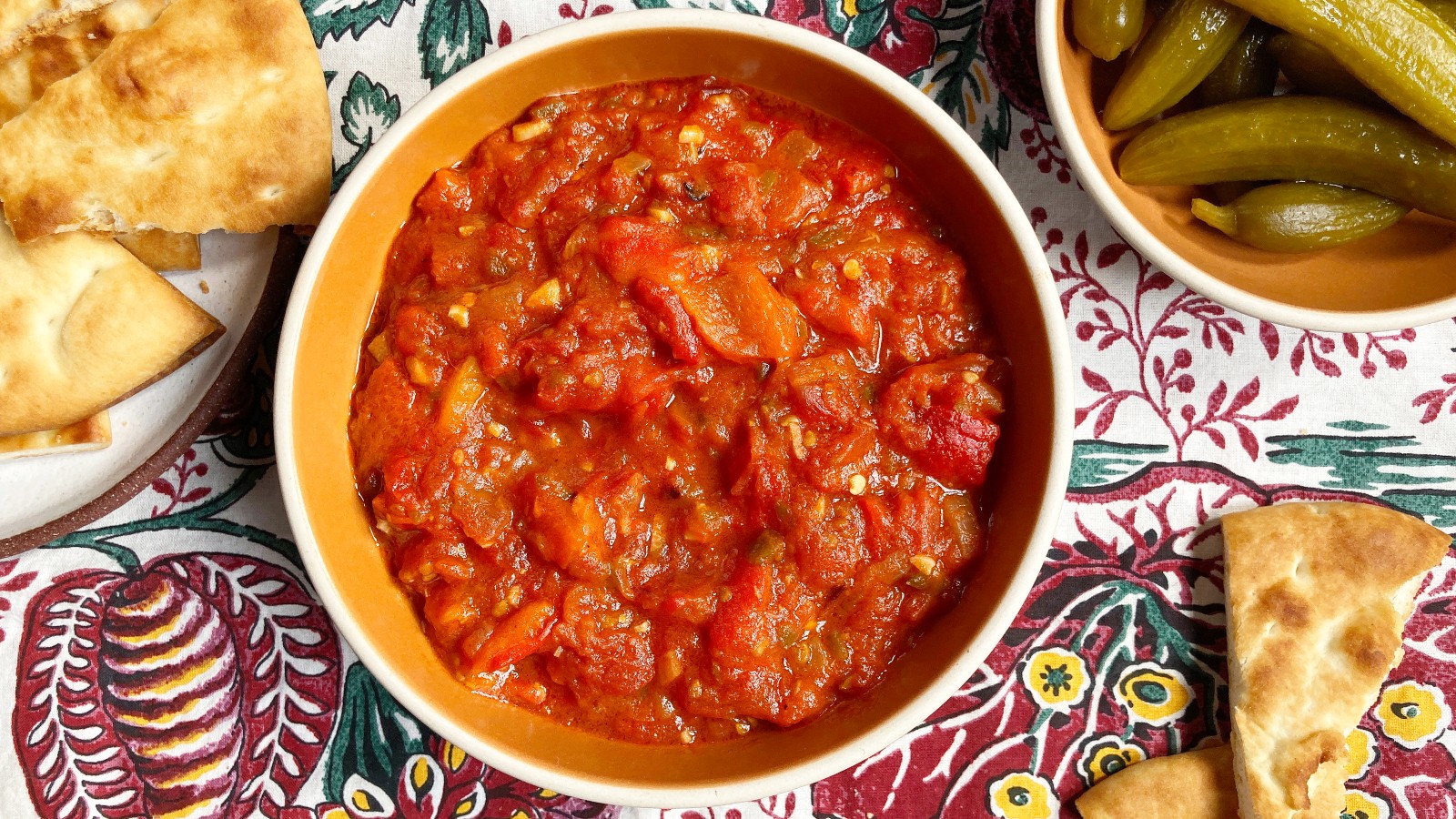Matbucha is a Maghrebi dish made of tomatoes and peppers and means “cooked salad” in Arabic. Jewish immigrants from Morocco, Tunisia, Algeria, and Libya brought matbucha with them to Israel, where it has become a staple of Israeli cuisine. Matbucha is nearly as popular as hummus, and the two are usually located right by each other at the grocery store.
Matbucha is technically a salad, but it does take serious cooking time. While store-bought versions are convenient, nothing compares to making this recipe at home. First, you roast tomatoes and peppers until they are charred with a smoky flavor, and then you simmer the matbucha for over an hour until it becomes thick and luxurious. The slow simmering process can’t be rushed, as all the flavor comes from the slow-cooked tomatoes. Matbucha varies from kitchen to kitchen, some cooks add onions and/or garlic, and some prefer making it with lots of hot peppers. Adding some fresh chilli pepper is traditional; in this recipe, it adds a very mild and subtle heat.
Matbucha has the consistency of a dip or spread, and it is commonly served with first-course salads (salatim) at the start of Middle Eastern and North African meals. Matbucha also makes a delicious topping for grilled meat or fish, as a sandwich spread, and it can even be used as the base for shakshuka.
Note: Matbucha can be eaten right after it cools, but it tastes even better the next day. It will last up to one week in the fridge.
The Nosher celebrates the traditions and recipes that have brought Jews together for centuries. Donate today to keep The Nosher's stories and recipes accessible to all.

Matbucha
An unbelievably delicious way to begin any meal.
- Total Time: 2 hours
- Yield: Serves 4
Ingredients
- 6 large Roma tomatoes
- 3 medium red bell peppers
- 1 jalapeño or Serrano pepper, seeded and diced fine
- ½ medium yellow onion, diced small
- 2–3 cloves garlic, minced
- 1 tsp salt, or to taste
- ¼ cup olive oil
- 1–2 tsp sugar (optional, or to taste)
Instructions
- Line a baking sheet with foil. Set the oven to broil (alternatively, you can char the peppers over a gas flame or grill).
- Place the tomatoes on one half of the baking sheet, and the peppers on the other half of the same baking sheet. Place the baking sheet on the top rack of the oven and broil the tomatoes and peppers for 10 minutes, or until blackened on top. Using tongs or a fork, remove the tomatoes. Turn the peppers onto their opposite side and continue to broil them until blackened on both sides, another 8-10 minutes. Watch your tomatoes and peppers carefully, as some ovens will broil them more quickly than others.
- Once the peppers are blackened on both sides, place them in a bowl and cover it tightly with foil or plastic wrap to let the peppers steam. Prep the other ingredients while the tomatoes and peppers cool. Once cool enough to touch, peel the peppers and remove their seeds, and peel the tomatoes. Dice the peppers and tomatoes and reserve.
- To a medium pot on medium heat, add the olive oil, diced jalapeño, diced onion, and minced garlic. Allow the mixture to cook and soften for 4-5 minutes, until the onion and garlic are aromatic but before they start turning brown. Add the peeled diced peppers and tomatoes to the mixture and bring it up to a simmer. Lower the heat and let the matbucha simmer for 90 minutes, or until most of the liquid has evaporated and the mixture significantly thickens. Stir every 10-15 minutes. Matbucha can take more or less time depending on the size of the pot you use, or the amount of liquid in the tomatoes. If the mixture still has a lot of liquid, continue to cook it for up to two hours.
- Once cooked, allow the matbucha to fully cool and then refrigerate.
Notes
Matbucha can be eaten right after it cools, but it tastes even better the next day. It will last up to one week in the fridge.
- Prep Time: 15 minutes
- Cook Time: 1 hour 45 minutes
- Category: Appetizer
- Method: Grilling
- Cuisine: Sephardi




Can it be frozen?
Yes! Defrost in the fridge.
Is it possible to preserve this in a water bath canner for long time storage?
We haven’t tried that, Catherine, but if you’re confident in canning we say go for it!